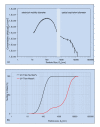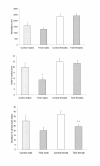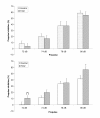Effects of prenatal exposure to surface-coated nanosized titanium dioxide (UV-Titan). A study in mice
- PMID: 20546558
- PMCID: PMC2908059
- DOI: 10.1186/1743-8977-7-16
Effects of prenatal exposure to surface-coated nanosized titanium dioxide (UV-Titan). A study in mice
Erratum in
- Part Fibre Toxicol. 2011;8:14
Abstract
Background: Engineered nanoparticles are smaller than 100 nm and designed to improve or achieve new physico-chemical properties. Consequently, also toxicological properties may change compared to the parent compound. We examined developmental and neurobehavioral effects following maternal exposure to a nanoparticulate UV-filter (UV-titan L181).
Methods: Time-mated mice (C57BL/6BomTac) were exposed by inhalation 1h/day to 42 mg/m(3) aerosolized powder (1.7.10(6) n/cm(3); peak-size: 97 nm) on gestation days 8-18. Endpoints included: maternal lung inflammation; gestational and litter parameters; offspring neurofunction and fertility. Physicochemical particle properties were determined to provide information on specific exposure and deposition.
Results: Particles consisted of mainly elongated rutile titanium dioxide (TiO2) with an average crystallite size of 21 nm, modified with Al, Si and Zr, and coated with polyalcohols. In exposed adult mice, 38 mg Ti/kg was detected in the lungs on day 5 and differential cell counts of bronchoalveolar lavage fluid revealed lung inflammation 5 and 26-27 days following exposure termination, relative to control mice. As young adults, prenatally exposed offspring tended to avoid the central zone of the open field and exposed female offspring displayed enhanced prepulse inhibition. Cognitive function was unaffected (Morris water maze test).
Conclusion: Inhalation exposure to nano-sized UV Titan dusts induced long term lung inflammation in time-mated adult female mice. Gestationally exposed offspring displayed moderate neurobehavioral alterations. The results are discussed in the light of the observed particle size distribution in the exposure atmosphere and the potential pathways by which nanoparticles may impart changes in fetal development.
Figures






Similar articles
-
Maternal inhalation of surface-coated nanosized titanium dioxide (UV-Titan) in C57BL/6 mice: effects in prenatally exposed offspring on hepatic DNA damage and gene expression.Nanotoxicology. 2013 Feb;7(1):85-96. doi: 10.3109/17435390.2011.633715. Epub 2011 Nov 28. Nanotoxicology. 2013. PMID: 22117692
-
Maternal inhalation of carbon black nanoparticles induces neurodevelopmental changes in mouse offspring.Part Fibre Toxicol. 2018 Sep 10;15(1):36. doi: 10.1186/s12989-018-0272-2. Part Fibre Toxicol. 2018. PMID: 30201004 Free PMC article.
-
NanoTIO(2) (UV-Titan) does not induce ESTR mutations in the germline of prenatally exposed female mice.Part Fibre Toxicol. 2012 Jun 1;9:19. doi: 10.1186/1743-8977-9-19. Part Fibre Toxicol. 2012. PMID: 22656316 Free PMC article.
-
What is the impact of surface modifications and particle size on commercial titanium dioxide particle samples? - A review of in vivo pulmonary and oral toxicity studies - Revised 11-6-2018.Toxicol Lett. 2019 Mar 1;302:42-59. doi: 10.1016/j.toxlet.2018.11.008. Epub 2018 Nov 20. Toxicol Lett. 2019. PMID: 30468858 Review.
-
An analysis of prenatal exposure factors and offspring health outcomes in rodents from synthesized nanoparticles.Reprod Toxicol. 2022 Jun;110:60-67. doi: 10.1016/j.reprotox.2022.03.014. Epub 2022 Mar 30. Reprod Toxicol. 2022. PMID: 35367333 Review.
Cited by
-
Titanium oxide nanoparticle instillation induces inflammation and inhibits lung development in mice.Am J Physiol Lung Cell Mol Physiol. 2013 Feb 1;304(3):L152-61. doi: 10.1152/ajplung.00013.2012. Epub 2012 Dec 7. Am J Physiol Lung Cell Mol Physiol. 2013. PMID: 23220372 Free PMC article.
-
Brazilian consensus on photoprotection.An Bras Dermatol. 2014 Nov-Dec;89(6 Suppl 1):1-74. doi: 10.1590/abd1806-4841.20143971. An Bras Dermatol. 2014. PMID: 25761256 Free PMC article.
-
Pulmonary response to surface-coated nanotitanium dioxide particles includes induction of acute phase response genes, inflammatory cascades, and changes in microRNAs: a toxicogenomic study.Environ Mol Mutagen. 2011 Jul;52(6):425-39. doi: 10.1002/em.20639. Epub 2011 Jan 21. Environ Mol Mutagen. 2011. PMID: 21259345 Free PMC article.
-
A review on potential neurotoxicity of titanium dioxide nanoparticles.Nanoscale Res Lett. 2015 Dec;10(1):1042. doi: 10.1186/s11671-015-1042-9. Epub 2015 Aug 26. Nanoscale Res Lett. 2015. PMID: 26306536 Free PMC article.
-
SiO2 and TiO2 nanoparticles synergistically trigger macrophage inflammatory responses.Part Fibre Toxicol. 2017 Apr 11;14(1):11. doi: 10.1186/s12989-017-0192-6. Part Fibre Toxicol. 2017. PMID: 28399878 Free PMC article.
References
-
- An inventory of nanotechnology-based consumer products currently on the market. http://www.nanotechproject.org/inventories/consumer/analysis_draft/
-
- Borm PJ, Robbins D, Haubold S, Kuhlbusch T, Fissan H, Donaldson K, Schins R, Stone V, Kreyling W, Lademann J, Krutmann J, Warheit D, Oberdorster E. The potential risks of nanomaterials: a review carried out for ECETOC. Part Fibre Toxicol. 2006;3(11):11. doi: 10.1186/1743-8977-3-11. - DOI - PMC - PubMed
-
- Schneider T, Jensen KA. Relevance of aerosol dynamics and dustiness for personal exposure to manufactured nanoparticles. Journal of nanoparticle research. 2009;11:1637–1650. doi: 10.1007/s11051-009-9706-y. - DOI
-
- Rossi EM, Pylkkanen L, Koivisto AJ, Vippola M, Jensen KA, Miettinen M, Sirola K, Nykasenoja H, Karisola P, Stjernvall T, Vanhala E, Kiilunen M, Pasanan P, Mäkinen M, Hämeri K, Joutensaari J, Tuomi T, Jokiniemi J, Wolff H, Savolainen K, Matikainen S, Alenius H. Airway Exposure to Silica-Coated TiO2 Nanoparticles Induces Pulmonary Neutrophilia in Mice. Toxicol Sci. 2010;113:422–433. doi: 10.1093/toxsci/kfp254. - DOI - PubMed
-
- Kreyling WG, Semmler-Behnke M, Seitz J, Scymczak W, Wenk A, Mayer P, Takenaka S, Oberdorster G. Size dependence of the translocation of inhaled iridium and carbon nanoparticle aggregates from the lung of rats to the blood and secondary target organs. Inhal Toxicol. 2009;21:55–60. doi: 10.1080/08958370902942517. - DOI - PubMed
Publication types
MeSH terms
Substances
LinkOut - more resources
Full Text Sources
Medical
Research Materials

